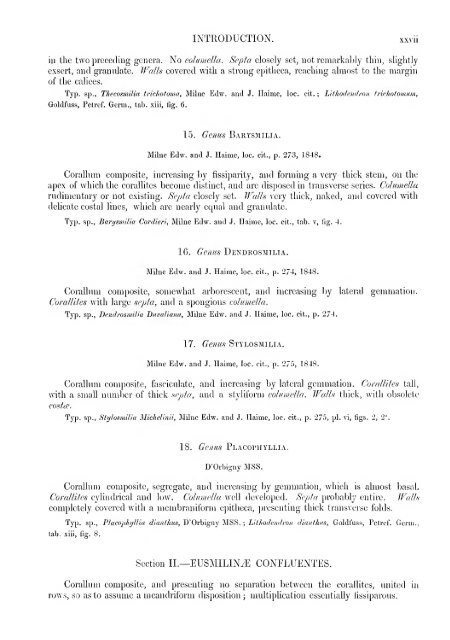A monograph of the British fossil corals - kreidefossilien.de
A monograph of the British fossil corals - kreidefossilien.de
A monograph of the British fossil corals - kreidefossilien.de
You also want an ePaper? Increase the reach of your titles
YUMPU automatically turns print PDFs into web optimized ePapers that Google loves.
INTRODUCTION.<br />
xxvii<br />
in <strong>the</strong> two preceding genera. No columella. Septa closely set, not remarkably thin, slightly<br />
exsert, and granulate. Walls covered with a strong epi<strong>the</strong>ca, reaching almost to <strong>the</strong> margin<br />
<strong>of</strong> <strong>the</strong> calices.<br />
Typ. sp., Thecosmilia trichotoma, Milne Edw. and J. Haime, loc. cit. ; Litho<strong>de</strong>ndron trichotomum,<br />
Goldfuss, Petref. Germ., tab. xiii, fig. 6.<br />
15. Genus Bauysmilia.<br />
Milne Edw. and J. Haime, loc. cit., p. 273, 1848.<br />
Corallmn composite, increasing by fissiparity, and forming a very thick stem, on <strong>the</strong><br />
apex <strong>of</strong> which <strong>the</strong> corallites become distinct, and are disposed in transverse series. Columella<br />
rudimentary or not existing. Septa closely set. Walls very thick, naked, and covered vdth<br />
<strong>de</strong>Ucate costal lines, which are nearly equal and granulate.<br />
Typ. sp., BarysmUia Cordieri, Milne Edw. and J. Haime, loc. cit., tab. v, fig. 4.<br />
16. Genus Dendrosmilia.<br />
Milne Edw. and J. Haime, loc. cit., p. 274, 1848.<br />
Corallum composite, somewhat arborescent, and increasing by lateral gemmation.<br />
Corallites with large sejjta, and a spongious columella.<br />
Typ. sp., Bendrosmilia Buvaliana, Milne Edw. and J. Haime, loc. cit., p. 274.<br />
17. Genus Stylosmilia.<br />
Milne Edw. and J. Haime, loc. cit., p. 2/5, 1848.<br />
Corallum composite, fascicidate, and increasing by lateral gemmation. Corallites tall,<br />
with a small nimiber <strong>of</strong> thick sejjta, and a styhform columella. Walls thick, with obsolete<br />
costa.<br />
Typ. sp., Stylosmilia Michelinii, Milne Edw. and J. Haime, loc. cit., p. 275, pi. vi, figs. 2, 2".<br />
18. Genus Placophyllia.<br />
D'Orbigny MSS.<br />
Corallum composite, segregate, and increasing by gemmation, which is almost basal.<br />
Corallites cyhncMcal and low. Columella well <strong>de</strong>veloped. Septa probably entii'e. Walls<br />
completely covered with a membraniform epi<strong>the</strong>ca, presenting thick transverse folds.<br />
Typ. sp., Placophyllia dianthus, D'Orbigny MSS. ; Litho<strong>de</strong>ndron dianthns, Goldfuss, Petref. Germ.,<br />
tab. xiii, fig. 8.<br />
Section II.—EUSMILIN^E CONFLUENTES.<br />
Corallum composite, and presenting no separation between <strong>the</strong> corallites, united in<br />
rows, so as to assume a meandriform disposition ; multiphcation essentially tissiparous.
















